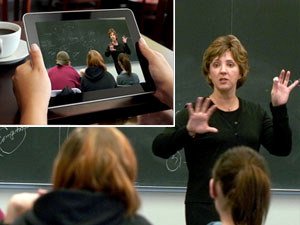Shattering the classroom walls

eLearning extends reach of U educational offerings
"eLearning shatters the idea that any class has to be constrained with respect to space or time," says U chemistry professor Chris Cramer. "The walls and boards of the traditional classroom disappear as connection to networked content, knowledge, and experts can take students and instructors anywhere in the world."
What is eLearning?
It's actually an old idea—using technology to support learning and increase access to it. The University of Minnesota has been doing it for nearly 100 years.
Some examples: In 1915, the U began producing educational films. In the 1940s, KUOM radio aired learning programs for children homebound by polio. The "Health Talk & YOU" TV show began running in 1987 (now there's a Health Talk blog). And in 1996, the U offered its first online courses.
Technology-enhanced active learning classrooms were piloted in 2007 at the U, which now has more of them than any other institution in the country. Faculty use them to "flip" their courses—shifting lectures online to free up in-class time for interaction with students.
MOOCs
Technology's revolutionary potential for education was felt again on February 20, 2013, when the U announced it would begin pilot testing a handful of MOOCs—massive open online courses.
The U reached an agreement with Coursera, launched in 2012 by two Stanford computer science professors. Their interactive online platform allows an instructor to teach even hundreds of thousands of students in a single course. Anyone will be able register for the U's five pilot MOOCs for free and for no credit.
"We're excited by the opportunity to explore innovative ways of using eLearning to extend the reach of University of Minnesota educational offerings across the state, nation, and globe," says U provost Karen Hanson, who is orchestrating the U's strategic approach to assessing the latest educational technologies.
"We believe MOOCs represent another new frontier in eLearning, one that we should explore, albeit with caution," she says. "MOOCs are not a sure thing for any of the universities engaging in them, and so this will be a small pilot that can help us assess the value of MOOCs to our long-range eLearning strategy."
Professor Chris Cramer, who is working with Provost Hanson as faculty liaison for eLearning initiatives and is teaching one of the pilot courses, agrees that the right role for MOOCs has yet to be determined. "To be honest, we're just not sure yet," he says. "We're all doing it for the first time. However, part of the attraction is being able to assess teaching effectiveness on very large numbers of students."
eLearning: multiplication rather than substitution
Besides MOOCs, the U's eLearning strategy includes targeting promising courses for enhancement or redesign, and offering graduate and professional students access to select programs in online or blended formats.
"It is important to note that eLearning works best when it multiplies what a good instructor can do," Professor Cramer says. "It is not really a substitute for an actively engaged instructor. But, constantly developing technologies have expanded the ways in which teachers can be maximally effective."
